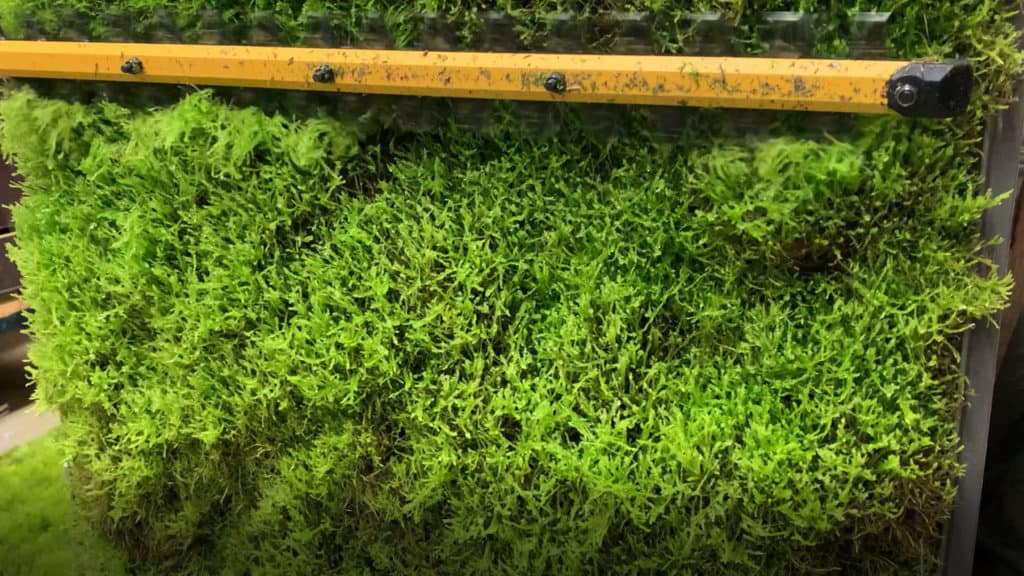WHY MOSS IS SHEARED ON THIS FARM IN BRANDENBERG
They are green and soft and grow vertically hanging in rectangular mats in Bestensee, Brandenburg: The “woolly fringemoss” and the “Common Hair Cap Moss” or the “springy turf-moss”. What sounds like something out of a fairy tale world are three of more than 16,000 moss species worldwide. They usually grow quite undisturbed and leisurely in forests or bogs, but here they thrive under optimal conditions and are being prepared for their use in various European cities. Of all things, the rather inconspicuous moss takes on the role of the high performer around which everything revolves.
And rightly so. Moss can bind and filter particles from the air like no other plant. It stores water and serves as a natural air conditioner through evaporative cooling. Because it does not draw the nutrients it needs for survival from the soil via roots like many other plants, but absorbs everything it needs via the air, it can reduce pollutants and fine dust. The surface of many fine, thin leaflets serves as an electrostatically charged trapping net. Most of the trapped fine dust is metabolized, which means that the moss grows on the dirt in the air, which significantly harms us humans.
MOSS AS AN AIR FRESHENER
We use these special abilities of moss to improve the air in cities. It is inserted into special bio-filters in the form of moss mats. A ventilation system draws in the polluted city air, heated in summer, and passes it through the dense layer of moss. The air leaving the moss is cleaner and fresher. In this way, air quality in the city is specifically improved where there are many people and where other greenery has a hard time taking root because of all the concrete. Moss filters are already in use in Berlin, London, Graz and numerous other cities.
The mosses used are grown in what is probably the world’s only moss farm near Berlin. And this is where everything starts with the moss shearing. This involves shearing the tops of the particularly dense, lush green mother crops with a shearing machine, just like sheep. The cut pieces of moss are dried for some time and then – seemingly little alive – placed in the carrier fabric of an air-permeable mat. There, a fluffy, dense, green carpet of moss grows, ready to take effect in its future “workplace” in urban spaces. In nature, it would take years to grow a moss carpet of this size and density, but in the moss farm, it takes just 12 weeks under the best conditions.
Mosses are the greenest and most sustainable means of air purification and cooling. Unlike conventional filters, no filter waste is produced. The well-being of the mosses is digitally monitored in the filters by smart technology. Depending on the weather, they are then supplied as needed and therefore only need to be replaced about every half year. The mosses are not disposed of, however, but recover for some time in their old home, the moss farm. After their little cure, they are then ready again for the hunt for dirty air in the next town.
The mosses used are grown in what is probably the only moss farm in the world – near Berlin. And here everything begins with the moss shearing. In the process, the tips of the particularly dense, rich green mother cultures are sheared with a shearing machine, just like sheep. The cut pieces of moss are dried for some time and then – seemingly little alive – placed in the carrier fabric of an air-permeable mat. There, a fluffy, dense, green carpet of moss grows, ready to take effect in its future “workplace” in urban spaces. In nature, it would take years to grow a moss carpet of this size and density, but in the moss farm, it takes just 12 weeks under the best conditions.
Mosses are the greenest and most sustainable means of air purification and cooling. Unlike conventional filters, no filter waste is produced. The well-being of the mosses is digitally monitored in the filters by smart technology. Depending on the weather, they are then supplied as needed and therefore only need to be replaced about every half year. The mosses are not disposed of, however, but recover for some time in their old home, the moss farm. After their little cure, they are then ready again to hunt for dirty air in the next town.


